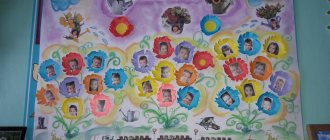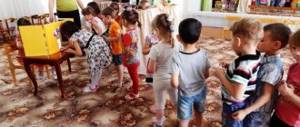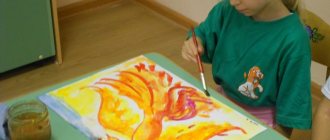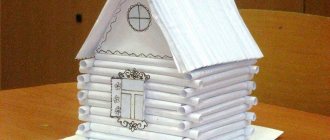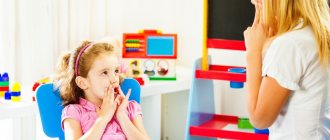The use of fiction in kindergarten classes is a powerful means of developing a harmonious personality. Reading helps improve a child's mental, aesthetic, speech abilities and skills. In the second younger group, more and more attention needs to be paid to reading, to cultivate a love of books. The lesson process itself can be structured in completely different ways - it depends on the tasks set and the topic of the chosen work.
- 2 How to read with children of the second youngest group
2.1 Organization of reading using the example of the Russian folk tale “Kolobok” - 2.2 Table: long-term plan for fiction (fragment, author Natalya Aleksandrovna Artyukhova)
- 2.3 Table: examples of GCD notes in the second junior group in fiction
The benefits of reading fiction for children 3–4 years old
In children aged 3–4 years, there is an active development of imagination and cognitive processes. The child is already able to emotionally evaluate and comprehend the texts of works: empathize with the characters, give an assessment, and draw conclusions.
Reading fiction develops imaginative thinking, fosters a love of reading, nature, and the world around us. Collective reading in a group helps the teacher to open up for children the world of relationships between people, the features of life in society.
Reading fiction develops imaginative thinking
Reading books is the path along which a skillful, intelligent, thinking teacher finds the way to a child’s heart.
V.A. Sukhomlinsky
The following goals for reading classes in the second junior group are set:
- developing a complete picture of the world;
- development of speaking skills;
- continued acquaintance with the artistic word;
- developing the ability to construct answers to questions;
- development of perception of artistic images;
- introduction to the culture of reading, the formation of a love for books;
- development of emotional reaction to events in works of art.
Books help children explore and understand the world around them
The objectives of a specific lesson may be:
- introducing children to literary works, meeting new writers;
- replenishment of vocabulary, familiarization with new words;
- developing the skill of expressive reading and intonation;
- expanding knowledge about the world around us (for example, getting to know professions while studying S. Mikhalkov’s poem “What do you have?”).
Nursery rhymes for bathing and washing
From the water, from the water Everything sparkles with smiles! From water, from water, flowers and birds are more cheerful! Dima washes his face and smiles at the sun!
Give me your hands, get out of bed, let's go wash up, where can we find some water!
The bunny began to wash himself. Apparently he was going to visit. Wash his mouth. Wash his nose. Wash his ear. It’s dry now.
Who will be there, squelching and squelching in the water? Quickly jump, jump, jump into the bathtub, jump, jump, jump with your foot in the bath! The soap will foam, and the dirt will go somewhere.
Glug, glug, glug, crucian carp. We wash in a basin. There are frogs, fish and ducklings nearby.
We will go swimming and splash in the water, splash, frolic, Nastya will wash. We will wash the feet of our sweet baby, we will wash the hands of Little Nastenka, the back and tummy, the face and mouth - what a clean dear daughter!
We swim, we splash, And we have fun in the water with you! Leg up, leg down! Handle up, handle down! Let's twist our legs and swim like ducks! Plop-plop! Bang-bang! Let's dry ourselves off!
Cheeks? Washed. Nose? Washed? What about the eyes? Forgot!
Oh-oh-oh-oh, Oh, who's naked? Who went swimming? Who found some water? Oh, the water is good! Good water! Let's give the baby a bath so that his face shines!
Who will be there, kup-kup, on the water - squelch-squelch? In the bath quickly - jump, jump, In the bath with your foot - jump, jump! The soap will foam, and the dirt will go somewhere.
Some water, some water, Wash my face, So that my eyes can look, So that my cheeks can blush, So that my mouth can laugh, So that my teeth can bite!
Some water, some water, Wash Dima’s face, Dima ate porridge, Got his face dirty. So that the boy is always the cleanest, Help, some water, to wash Dimino’s face.
We'll go swimming and splash in the water, splash and frolic, and the little one will wash himself. We will wash the feet of our dear baby, We will wash the hands of our dear little boy, the back and tummy, the face and mouth - that’s how clean our dear Son is!
Tap, open! Nose, wash your face! Wash both eyes at once! Wash your ears, Wash your neck! Cervix, wash yourself thoroughly! Wash, wash, shower! Dirt, wash away! Dirt, wash away!
Sea-sea, Silver bottom, Golden coast, Drive shavings along the waves! Light boat, Golden Bottom, Silver merry, Little tree, Green trawls. Sail away, little boat!
The little cat woke up early, ran to the bridge, washed his face white. I washed my nose, washed my tail, and didn’t forget about my paws.
Ay, okay, okay, we are not afraid of water, we wash ourselves clean, we smile at mom. Flowing water, A growing child, Water off a duck's back - Thinness off a child. The water is down, and the child is up.
Ay, okay, okay, okay We are not afraid of water, We wash ourselves clean, We smile at Mom. We know, we know, yes, yes, yes, where are you hiding, water! Come out, water, we came to wash ourselves! Place it on your palm and on his leg. Shower, shower, shower Be bold - Dima, wash your face more cheerfully!
A fish lived in the lake, and swam to you and me. (At the same time, move your hand under the water, as if the fish were swimming). We will wash the baby, we will catch fish. The water is not cold for us. Where is the fish? Here she is! (quietly splash some water on the baby)
Ears? Washed, Paws? Washed, Ponytail? We washed, we washed everything, and now we are clean, fluffy bunnies.
The mirror loves clean faces, The mirror will say: “I need to wash myself,” The mirror will groan: “Where is the comb?” It’s not like she won’t comb the child’s hair, The mirror even darkens with fear, If a slob looks at it.
Clean clean chimney sweep - clean clean, clean clean There will be a chimney sweep clean clean clean clean.
Turn on the shower and adjust the water. Select a water pressure such that the stream is not harsh and puts light pressure on the baby’s skin. Wash the baby’s arms, legs, back, and tummy in a circular motion, saying:
We will wash our arms, legs and head deftly with a shower. Pour, pour, water. We will always be clean!
While bathing, help your baby recognize himself better. While you wash him, sing a song about different parts of his body.
Mine, wash the baby Mine cleanly, slowly: Let's soap the shoulders - wash with some water Wash the neck - clean neck! Let's wash our hands and palms a little, Where is our tummy? Let's wash my tummy...
How to read with children of the second youngest group
In the second junior group, it will be useful to use the following techniques in the classroom:
- artistic expression - reading a text;
- teacher's story - here you can read the text or retell it, using various means to help: toys, puppet theater, pictures, filmstrips;
- learning by heart;
- individual reading and choral speaking;
- combining two types of arts - viewing pictures, listening to music while reading;
- staging (for example, acting out the fairy tale “Turnip” using finger toys or figurines);
- didactic games.
Should be read to children daily. There must be a book corner to which children will have constant access. There you need to place several books studied according to the program, as well as books recommended for study in your free time. At the age of 3-4 years, daily reading before bed after lunch is mandatory.
It’s better when parents also support their child’s involvement in reading.
Before reading a work to children, the teacher should read it himself and analyze it. Here you need to pay attention to the following points:
- Determine what the child can understand on his own in the book, and what needs to be explained for better assimilation.
- Mark passages and words in the text that will help develop speech when they are repeated (for example, the teacher reads the passage: “Little goats, kids! Open up, open up! Your mother came and brought milk...” (“The Wolf and the Seven Little Kids”), then reads some more times the phrase and asks the guys to finish it).
- Intonation moment: the teacher should highlight emotional moments with intonation.
- Selection of illustrations for the book.
Conducting a more comfortable lesson without overloading children with unnecessary information and fatigue will be facilitated by:
- changing teaching techniques with game ones (for example, after reading S. Marshak’s poem “The Tale of a Stupid Mouse,” you can play the game “Find the Mouse”);
- alternation of group and individual responses of children (both verbal and motorically expressed);
- inclusion of demonstration materials (toys, figurines, drawings, etc.) into the lesson - this pleases the kids and helps focus their attention;
- using actions that will require the children to change their position, move (for example, “Children, let’s look where the cat hid” - and look under chairs and tables). This technique significantly enlivens the activity, enlivens the child’s imagination and prevents fatigue.
Organization of reading using the example of the Russian folk tale “Kolobok”
The objectives of the lesson are to introduce the children to the fairy tale “Kolobok” and teach them word formation.
It is easier for children of primary preschool age to perceive text accompanied by illustrations
The lesson can be structured as follows:
- Introductory part. The teacher conducts a conversation with the children, asks who Kolobok is, whether the children have heard of him before (from home reading, cartoons).
- Then reading an excerpt from a fairy tale: “I kneaded the dough with sour cream, rolled it into a bun...” (kids demonstrate with their hands how to make a bun).
- Expressive reading of a fairy tale (here it is worth emotionally highlighting the moments of joy when Kolobok manages to escape from the animals so that the children rejoice, and the moment of grief when the fox deceived him with her cunning).
- The teacher repeats with the children what different animals said to the kolobok (“Kolobok, kolobok, I’ll eat you!”).
- Word game (“Guys, now let’s play! I will tell you words that denote a large object, and you will say words that denote the same objects, only smaller: table - table, cup - cup”).
- Then the teacher shows the children drawings for the fairy tale “Kolobok”, saying that many famous artists have depicted Kolobok.
The teacher must make full use of the necessary methodological techniques for mastering the material, developing listening skills, and reading comprehension. Expressive reading of a work helps children better remember the material and evaluate it. When discussing what you read, you can use a comparison of a situation in a book with a comparison of a real-life incident, and give hints when answering.
Expressive reading will help you remember the material better
When choosing a topic for a lesson, it will be very useful to associate it with some holiday or time of year for the children to better assimilate the material.
Table: long-term plan for fiction (fragment, author Natalya Aleksandrovna Artyukhova)
| Month | Subject | What are the lessons aimed at? |
| September | Poem “The Preacher” by Sasha Cherny |
|
| Russian folk tale "Cat, Rooster and Fox" |
| |
| Russian folk tale "Three Bears" |
| |
| October | Reading the Russian folk tale "Kolobok" |
|
| Reading poems by A. Barto from the “Toys” cycle |
| |
| Reading poems by A. Blok “Bunny” and A. Pleshcheev “Autumn” |
| |
| November | Russian folk nursery rhymes “Kitsonka-murysenka”, “The cat went to market” |
|
| Russian folk tale “Sister Alyonushka and Brother Ivanushka” |
| |
| Reading poems about mom |
| |
| Reading a fairy tale in verse by K.I. Chukovsky "Moidodyr" |
| |
| December | Russian folk tale "Masha and the Bear" |
|
| S.Ya. Marshak "The Tale of a Stupid Mouse" |
| |
| Russian folk tale "The Fox and the Wolf" |
| |
| January | L. Voronkova story “It’s snowing” | Introduce a work of art, reviving in the children’s memory their own impressions of the snowfall. |
| Russian folk tale "The Snow Maiden and the Fox" |
| |
| E. Charushin story “Wolf” |
| |
| February | Russian folk tale "The Wolf and the Seven Little Goats" |
|
| Z. Aleksandrova’s poem “My Teddy Bear” |
| |
| Russian folk tale "Rukavichka" |
| |
| Russian folk tale "The Cockerel and the Bean Seed" |
| |
| March | E. Blaginina, poem “This is what a mother is like” |
|
| Reading of A. Pleshcheev’s poem “Spring” |
| |
| Russian folk tale “Fear has big eyes” |
| |
| L. N. Tolstoy's story “Truth is more precious than anything else” |
| |
| April | Reading the Russian folk tale "Geese and Swans" |
|
| K. Chukovsky reading the story “Chicken” |
| |
| Russian folk tale “Bull-black barrel, white hooves” |
| |
| May | Reading the story “Holiday” by Ya. Taits |
|
| V. V. Mayakovsky “What is good - what is bad?” |
| |
| S. Marshak poem “Children in Cages” |
|
In pedagogical practice, there is a huge amount of materials to help teachers conduct classes.
Table: examples of GCD notes in the second junior group in fiction
| Author and title of the abstract | Description of material |
| Tatiana Osipova. “Reading the Russian folk tale “Geese and Swans” | Notes on reading the Russian folk tale “Geese and Swans” (aimed at the general artistic development of children, and also serves other educational purposes). |
| Ksenia Yakovleva. “Reading the fairy tale “The Wolf and the Seven Little Goats” | The notes will help in planning a fairy tale reading lesson, the purpose of which is to instill in children a love for animals and teach them to empathize with them. |
| Olga Yantsen. “Reading the fairy tale “Kolobok” | The summary is aimed at developing spoken language in children of the second younger group. |
| Galina Kochulova. Integrated lesson in the second junior group on familiarization with fiction “Teremok” | Lesson summary using non-traditional appliqué technique (“Palms”). |
Poems for memorization second junior group
Children's poems: to kindergarten
Shape: cool | beautiful | short
If the Christmas tree had legs, it would run along the path.
If she danced with us, she would knock her heels.
Toys would spin on the Christmas tree - Multi-colored lanterns, Firecrackers.
Flags made of crimson and silver paper would spin on the Christmas tree.
They would laugh at the Matryoshka Christmas tree and clap their hands for joy.
Because the New Year is knocking at the gate!
2
Our Tanya is crying loudly: She dropped a ball into the river. - Hush, Tanechka, don’t cry: The ball won’t drown in the river.
3
The cockerels started to fly, but did not dare to fight. If you get too cocky, you might lose your feathers. If you lose your feathers, there will be nothing to rooster with.
4
The grass is turning green, the sun is shining; A swallow flies towards us in the canopy with spring. With her the sun is more beautiful And spring is sweeter... Chirp from the road Greetings to us soon! I’ll give you grains, and you sing a song that you brought with you from distant lands...
5
The lingonberries are ripening, the days have become colder, and the cry of birds only makes the heart sadder. Flocks of birds fly away across the blue sea. All the trees shine. Multi-colored attire. The sun laughs less often. There is no incense in the flowers. Soon autumn will wake up and cry awake.
6
The mice dance in a circle, the cat is dozing on the bed. Quiet, mice, don’t make noise, don’t wake up Vaska the cat. When Vaska the cat wakes up, he will break up the whole round dance.
7
Cucumber, cucumber! Don't go to that end - a mouse lives there and will bite your tail off.
8
Autumn has arrived. The flowers have dried up and the bare bushes look sad. The grass in the meadows withers and turns yellow
9
We take fruits in our hands and put them in a basket: Plum, peach, orange, pear, kiwi, tangerine.
10
We will cook compote. We need a lot of fruit. Here. We will chop apples, we will chop pears. Squeeze out the lemon juice, add the drain and sand. We cook, we cook compote, Let's treat the honest people.
11
Mushrooms and berries One, two, three, four, five...
One two three four five. We will look for mushrooms. Boletus, boletus, Russula and honey mushrooms.
12
A playful squirrel jumps, tears cones from spruce branches, and then jumps to the ground and finds the boletus. The mushroom will be strung on a twig - Dry yourself, little boletus!
13
Kindergarten, kindergarten! You're always welcome to the guys! Books and toys are waiting for us, and balls and rattles... We go to kindergarten in the morning. The kids are very happy. We do a round dance: You can do it backwards. You can jump and gallop, and call your friends. We played and sang, sat down on a bench to relax... And now, kids, it’s time to have lunch!
14
We are helping at the dacha. We will be with our brother again! As soon as I approached the garden bed - Oh, the nettle stung! It hurts me, but I don't cry. We work in the country. Field, field in order... They were exhausted from the heat. We looked back at the garden bed - No carrots, no herbs...
15
On the street three hens are fighting with a rooster. Three girls look through the window and laugh: “Shoo-shoo! Ha ha ha! Have pity on the rooster!
More poems: 10
All poems for memorization
